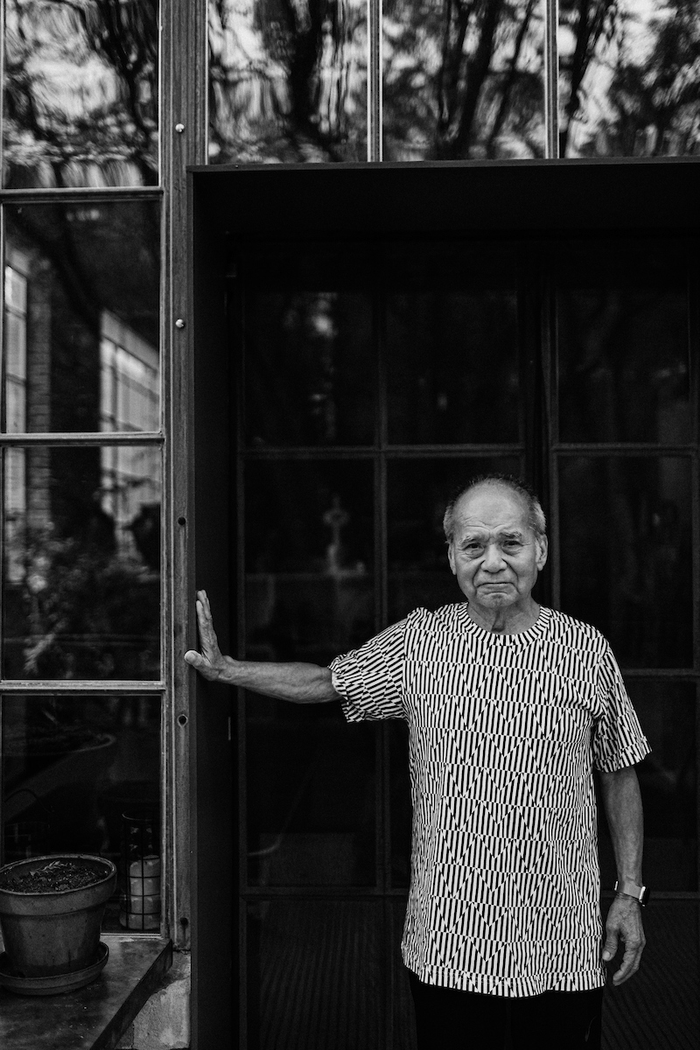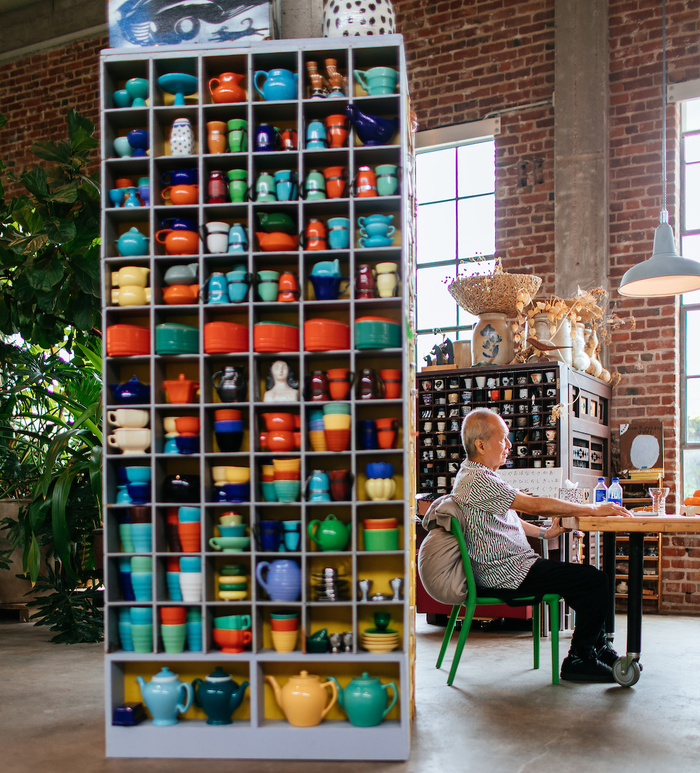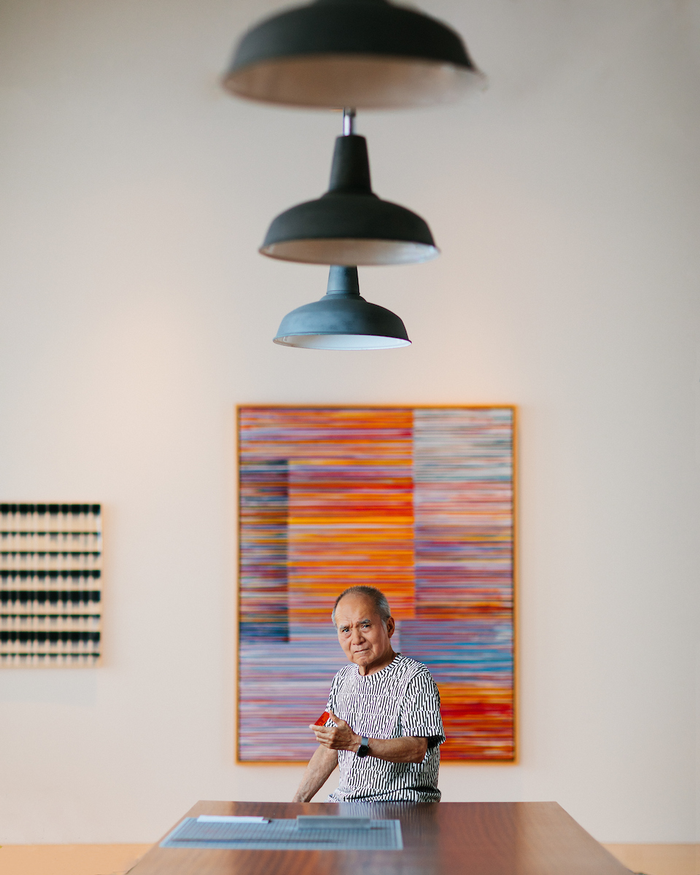"What does it mean?"
It is often said to be the question that makes every artist cringe.
The path to enlightenment, it seems, begins not with a step but with a shortcut. Positively pregnant with a half-hearted need for clarification that borders on the uninclined, the question concerns itself far less with the artist’s inspiration than the patron’s interpretation.
Jun Kaneko doesn’t hate the question. He swears he doesn’t. But every time he hears it, he isn’t quite sure what the question is either.
“I say, ‘I wish I knew the answer,” he said. “Because that’s what I’m looking for, too. When you find out what it means, that’s the end of it, isn’t it? If you completely understood what you’re looking for and then you understand what you’re looking at, what’s next? That’s it. You have to quit. Questions are tricky. The questions you ask yourself could help your truth, but they could kill you.”
Kaneko hasn’t quit yet. He’s still seeking the answers and the questions that consume him and his art.

Photo by Bill Sitzmann
An internationally acclaimed sculptor best known for his ceramic “dangos”—named for the sweet dumplings of his childhood—that resemble swollen, three-dimensional canvases of abstract graphics and colors, Kaneko has called Omaha home for more than 30 years. Now 79 and diagnosed with Parkinson’s Disease, he can still be found most days in his studio, where he’d much rather be making art than talking about it. His work? That’s the same as it ever was.
Bold. Contemplative. Playful. And wholly his own.
Kaneko’s sculptures are included in more than 40 museum collections internationally and more than two dozen public art commissions bear his name around the world. All of it painstakingly created—or at the very least conceived—in his Omaha studio. He and wife, Ree Schonlau Kaneko, have been Omaha arts scene mainstays since the 1980s. They were instrumental in the founding of the Bemis Center for Contemporary Art before opening their Kaneko Gallery in 1998. All of it housed on a near city block of century-old former warehouses at 11th and Jones streets in the Old Market.
For half a century, Kaneko has immersed himself in the contemporary ceramics movement and come out the other side as world renown as he is enigmatic about what makes his work uniquely his.
“I just like to do my own thing,” Kaneko said. “Even making my own pieces I don’t know if I’m doing good stuff or bad stuff or making a ton of trash.”
How Kaneko found himself in Omaha still seems to surprise the artist. And not unlike his transition from self-described abstract painter to ceramic sculptor, both happened nearly by chance.
Born in Nagoya, Japan, in 1942, Kaneko arrived in America in 1963 with $300 in his pocket, little knowledge of the English language, and a plan to study painting at Chouinard Institute of Art. In Los Angeles, Kaneko was taken in by Fred and Mary Marer. The Marers happened to be avid collectors of what was then a relatively new art form: modernist ceramic sculpture. Kaneko can still recall the Marers’ tiny apartment jam packed with colorful, glazed sculptures unlike anything he’d ever seen.
“I would look at it and think, ‘This is something,’” Kaneko said.
Kaneko didn’t realize it at the time, but he had landed smack dab in the middle of the American Contemporary Ceramics Movement. His interest soon became obsession. The young artist went on to study under Peter Voulkos, Paul Soldner, and Jerry Rothman, all masters of the era. Rothman first gave Kaneko clay of his own and a corner of his studio in which to experiment.
“It was a ton of mixed clay,” Kaneko said. “He dumped it on the floor and told me to go to work. He didn’t teach me anything about it.”
Kaneko began by making flat, ceramic slabs and painting them because “…that’s what I knew how to do.” He had no idea if he was any good but kept at it. He made hundreds of flat slabs and painted them. Then he got tired of it. He wanted something more. He slapped two slabs upright together as a “more three-dimensional piece, with a front and back.”
Then it began to bother him that his pieces had a front side and a back side.
“I always had one side I liked better than the other,” he said. “When you take a picture of the side you like and send it, the back side, nobody knows. So I decided it wasn’t good.”
He then began molding the shape, making it more spherical, more three-dimensional, without edges, with neither back nor front. For the next few years he experimented until it looked “interesting enough,” he said. “It was gradual but it took shape.”
By the mid 1960s, Kaneko had transitioned out of painting to sculpture, although the former was always integral to the latter.
Over the following decade, Kaneko taught ceramics at leading art schools Scripps College, the Rhode Island School of Design, and the Cranbrook Academy of Art. All the while, he developed what would become his signature style, reflecting his origins as a painter and embracing the ceramic artist in him. His dangos, his giant sculpted heads, and wall plates seem to push at the limits of their creative space from meager beginnings as lumps of dull gray clay.
In 1983 Kaneko was commissioned for his first large scale endeavor: the Omaha Project at the former Omaha Brickworks. It was around this time that Kaneko would give up teaching and pursue his work full time. A chance encounter with then-Ree Schonlau not once, but twice, would change the geographical trajectory of exactly where he would work.
“If I didn’t see her that [second] time, I probably [would not have] come to Omaha,” Kaneko said of his future wife.
After considering studio space on the East and West coasts, Ree convinced him to consider real estate options in Omaha’s downtown. Kaneko purchased a 40,000 square foot former brick warehouse in the Old Market in 1990.
When he first made the move, he got questions from other artists curious why he chose Omaha of all places as his base of operations.
“I had quit my job, I had no income, I wasn’t selling at all and I came to Omaha where there wasn’t that big of support for art at the time,” he said. “So a lot of people were checking me out to see if I was still alive.”
The new studio came at a fraction of what he might have paid in New York or Los Angeles, and gave Kaneko space and solitude—two things the artist known for creating larger-than-life sculptures that can weigh hundreds of pounds and extend more than 10 feet tall was positively giddy about. Some works can take as much as 18 months to dry and years to paint. The ceramic creative process is as lengthy as it is measured, from the shaping of the piece from raw clay, to the drying, to the glazing, to the kiln firing, and the cooling. Each step is impacted as much by his own hand as climate and gravity.
“Everything I do takes a really long time to develop. Even glazing. I even keep changing my glazing technique. You can just apply the glaze or spray it or brush it on or dip it but there’s so many ways of doing that.”
Kaneko thinks he learns something about himself and his art with every new piece, every velvety layer of glaze, and every brushstroke over years of working on a project.
“Some artists want to figure everything out before they start, like in conceptual art. Lots of artists try to figure it all out as close as they can so they don’t waste their time,” Kaneko said. “In my case, it’s more like an intuition. I do one thing and that changes a piece. And then I add something to it and then I think about how to improve that and do another thing. It’s a back and forth. It’s a conversation. I always have to have as open a mind as possible before I start something.”

Photo by Bill Sitzmann
That dialogue gives each of Kaneko’s works its own distinctive skin, painted and glazed by hand and in patterns as varied as dots, zigzags, or lines that never feel perfunctory. The Smithsonian American Art Museum described the overall visual effect of his work as “one of disciplined repose...by reducing his imagery to simple, archetypal symbols of nature, and minimizing the range of his colors, Jun Kaneko has created contemplative ceramic sculptures that celebrate universal aesthetic principles.”
Littleton Alston, an associate professor of sculpture at Creighton University who has known Kaneko for over two decades, compares Kaneko’s work to haiku: a poetic conversation that “elevates creative language.”
“What you have to not fall for is they’re bright, they’re big,” Alston said. “No, no, no that’s not what they’re about. That’s the language he uses but what he’s doing is speaking words that aren’t filler. It’s not a filler conversation. If he’s saying something, you better listen to every word. What he has done is considered, and thought about, every single word in context to all of history.”
When other artists see Kaneko’s work they sense the pursuit of perfection in each piece. Alston has seen Kaneko destroy works if they weren’t what he wanted. But if you look closely at that “perfection,” Alston said, you get a glimpse of how large work can communicate in the same way a fine porcelain potter applies an intentional “human mark” on a work to indicate the humanity of the act and a oneness with the material.
“The man is a lion,” Alston said. “And that’s not an understatement. He understands all of what he’s doing in reference to all of history. Don’t underestimate that. It’s not a black-and-white contrast. He is that beautiful, eloquent refinement that comes out in very subtle conversations, not a bullhorn.”

Photo by Bill Sitzmann
Kaneko’s impact on the Omaha visual arts scene certainly hasn’t been quiet. His studio, his gallery, and the work he and Ree have done to help lead a revival of downtown has had its own trickle-down effect on the art scene. They’ve proven art and artists can flourish somewhere besides New York.
The Kaneko’s downtown space has become a landmark in the Old Market. In 2019, an atrium entrance was unveiled that links the three brick warehouses and the 400,000 square feet that make up the complex. The gallery is dotted with Kaneko’s large-scale ceramic pieces as well as work by other artists. In addition to exhibitions, the gallery hosts readings, lectures, and film and music presentations all centered around four major themes: design, ideas, performance, and innovation.
The gallery is currently holding a $30 million capital campaign to construct an additional building that will permanently house the artwork and artifacts in the Jun Kaneko Collection.
Alston is well aware of Kaneko’s path to Omaha, and “Omaha, the state of Nebraska, are damn lucky he stayed,” he said. Too many artists for the Creighton professor to name came to Omaha either through the Bemis or to work with or for Kaneko and many stayed, bringing their creativity and revenue to the state.
“He is the catalyst for that,” Alston said. “And the Bemis is a catalyst for a lot of that. And The Kaneko is catalyst for a lot of that. Just because it doesn’t fall in the ‘Beef, it’s what’s for dinner,’ it is much more deeper than that. We need to understand that when we open up our understanding of what art is and what it does in the world.
“You look at who was doing what first and who was doing it best and he’s right in there. You can’t talk about art history without talking about Jun Kaneko.”
Kaneko admitted Parkinson’s has slowed him. But he still works most days. Between his work, gallery shows, and the occasional public commission, Kaneko has a staff of full-time assistants to help. Ree handles much of the business side and he’s fine with that. The last year hasn’t been an easy one for him, or anyone, he said. The pandemic shuttered galleries and many may not reopen. The arts, like all businesses, have suffered considerably.
“It’s influenced me to look at a piece differently,” Kaneko said. “I always said there’s no way any interesting situation or piece has only one side, even if it’s a good piece or a bad piece. Even good pieces have a not-so-good side. And the piece you don’t like can have a positive side. That’s the case all the time. Nothing is just flat. The thing is if you can’t see the other side, that’s the problem.”
Time, Omaha, a Parkinson’s diagnosis and the pandemic have not changed Kaneko’s work. But they perhaps have changed his perspective on his work—both in progress and when he must walk away from it.
“I’m trying to find the positive side all the time,” Kaneko said. “And I keep on adding positive, on top of positive, on top of positive. If it goes that way, I’m lucky it will end up an OK piece. But sometimes I miss the other side of it. I’ve been doing this 60 years already. I’m thinking about what happens on that other side.”
Visit junkaneko.com for more information.
This article originally appeared in the July/August 2021 issue of Omaha Magazine. To receive the magazine, click here to subscribe.











